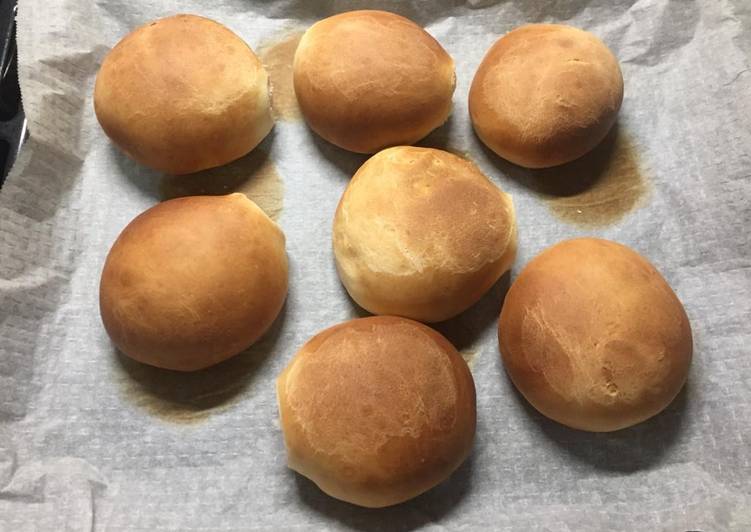
Hello everybody, it is me again, Dan, welcome to my recipe site. Today, I’m gonna show you how to prepare a special dish, 🥐🥐 croissant 🥐🥐. One of my favorites. This time, I am going to make it a bit unique. This will be really delicious.
🥐🥐 Croissant 🥐🥐 is one of the most favored of current trending foods in the world. It’s appreciated by millions every day. It is easy, it’s fast, it tastes delicious. 🥐🥐 Croissant 🥐🥐 is something that I’ve loved my entire life. They’re nice and they look wonderful.
The croissants were light flaky and tastes great. I used a little more flour as well used pastry four instead of all-purpose. It made them a little more lighter.
To begin with this particular recipe, we must first prepare a few components. You can cook 🥐🥐 croissant 🥐🥐 using 5 ingredients and 11 steps. Here is how you can achieve that.
The ingredients needed to make 🥐🥐 Croissant 🥐🥐:
- Take 400 g white all purpose flour 250 g unsalted butter
- Make ready 250 ml milk 60 g sugar
- Get 2 tsp dried yeast 1 tsp salt 1 egg (optional)
- Prepare For the glaze
- Get 1 egg yolk 1 tbsp milk
Butter a large bowl; set aside. Croissant dough begins with butter, flour, sugar, salt, yeast, and milk. Unlike most yeasted doughs that require warm liquid to activate the yeast, you're going to use cold milk. The yeast will work its magic later on in the recipe.
Steps to make 🥐🥐 Croissant 🥐🥐:
- Add the yeast to the milk, stir and leave for 10 minutes for the yeast to activate. - Sieve the flour into a bowl and add the sugar and salt. Mix well then make a well in the centre. Add the milk/yeast and the egg. Mix well to form a smooth dough. - Turn the dough out onto a floured surface and knead for 3-4 minutes.
- Place the dough in a lightly-greased bowl, cover and allow the dough to rise until doubled in size. - Place a piece of plastic film at least 45cm x 25 cm (18"x 9") on a flat surface, put the block of butter in the centre then cover with another piece of plastic film.
- Roll the butter out to about 30 cm x 12 cm (12"x 5"). - Turn the risen dough out onto a floured surface, knock it back and roll it out to about 45 cm x 15 cm (18"x 6"). - Peel off one layer of plastic film from the butter and turn the butter onto the bottom two-thirds of the dough. Remove the plastic film and make sure there is a 1cm (½") border between the butter and the edge of the dough.
- Turn the top third of the dough over the butter, then turn the bottom third over the top third. Pinch the edges of the dough together, place in a plastic bag and refrigerate for at least 45 minutes to de-soften the butter. - Take the dough out of the bag and put it on the lightly floured work surface with the short end towards you.
- Roll the dough out to 45 cm x 15 cm (18"x 6"). Fold up one-third of the dough and then fold the top third down on top to make a neat square. This is called a single turn. Put the dough back into the plastic bag and chill for another 30 minutes. Repeat this stage twice more, putting the dough back into the fridge for 30 minutes between turns. - After the final turn leave the dough in the fridge for at least 1 hour, or overnight, to rest.
- Put the dough onto a lightly floured surface and roll out to a rectangle a little more than 45 cm x 30 cm (18"x 12"). Trim the edges to neaten them. - Cut the rectangle lengthways into 2 strips each of which is 15 cm (6") wide. Make small cuts every 15 cm (6") along one side and do the same on the other long side but starting 7½ cm (3") from one end. - Use the cutmarks as a guide to cut out 5 triangles per strip of dough. Keep the small triangles at the end to make mini-croissants.
- Make a cut about 1 cm (½") long in the middle of the base of each triangle. Before rolling, gently stretch the point of the triangle then gently stretch the base of the triangle. - Starting at the wide end of each triangle, roll it up into a croissant. Make sure the point of the triangle is underneath the croissant then turn the ends in to give the traditional croissant shape.
- Grease two baking trays and place the croissants on the trays leaving space in between for them to expand; allow 4-6 per tray.Put each tray inside a clean plastic bag and leave the croissants to rise at room temperature until at least doubled in size.Prepare the glaze by whisking together the egg yolk and the milk. Brush the top and sides of the croissants with glaze.Bake at 180°C/356°F fan oven, 200°C/392°F conventional oven for around 15 minutes until golden brown.Leave on a wire rack to cool.
- #Notes: - - If you have used the egg in the recipe your initial dough may be slightly tacky. You can deal with this when you knead the dough by kneading in a handful of extra flour. - - You don't want to knead this dough too much or it will be difficult to roll out later on in the recipe.
- You can freeze the dough at almost any stage. I usually make enough dough for several batches and freeze it before I roll it out to cut the triangles. You can also freeze the unrisen croissants and can even freeze the baked croissants. - Croissants are best eaten fresh and warm but they will keep for 2-3 days in a sealed bag.
In the beginning steps of croissants, the dough should always be cold. The notch helps the rolled croissant curl into a crescent. Lay the croissant on the work surface with the notched side closest to you. If you have never had a croissant before, boy are you in for a treat! Croissants are a classic French pastry, rolled and shaped into a crescent.
So that is going to wrap it up for this exceptional food 🥐🥐 croissant 🥐🥐 recipe. Thank you very much for reading. I’m sure you can make this at home. There’s gonna be interesting food in home recipes coming up. Don’t forget to bookmark this page in your browser, and share it to your family, colleague and friends. Thanks again for reading. Go on get cooking!


